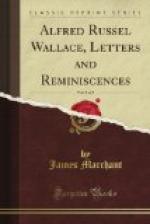“Rain, sun, and rain! and the free
blossom blows;
Sun, rain, and sun! and where is he who
knows?
From the great deep to the great deep
he goes.”
And whilst facing with brave and steady mind the great mysteries of earth and sky, of life and what lies beyond it, he himself loved to quote:
“Fear not thou the hidden purpose
Of that Power which
alone is great,
Nor the myriad world His shadow,
Nor the silent Opener
of the Gate.”
Among the scientific friends to whom he appealed for help when writing his astronomical books was Prof. (now Sir) W.F. Barrett.
* * * * *
TO PROF. BARRETT
Parkstone, Dorset. February 12, 1901.
My dear Barrett,—I shall be much obliged if you will give me your opinion on a problem in physics that I cannot find answered in any book. It relates to the old Nebular Hypothesis, and is this:
It is assumed that the matter of the solar system was once wholly gaseous, and extended as a roughly globular or lenticular mass beyond the orbit of Neptune. Sir Robert Ball stated in a lecture here that even when the solar nebula had shrunk to the size of the earth’s orbit it must have been (I think he said) hundreds of times rarer than the residual gas in one of Crookes’s high vacuum tubes. Yet, by hypothesis, it was hot enough, even in its outer portions, to retain all the solid elements in the gaseous state.
Now, admitting this to be possible at any given epoch, my difficulty is this: how long could the outer parts of this nebula exist, exposed to the zero temperature of surrounding space, without losing the gaseous state and aggregating into minute solid particles—into meteoric dust, in fact?
Could it exist an hour? a day? a year? a century? Yet the process of condensation from the Neptunian era to that of Saturn or Jupiter must surely have occupied millions of centuries. What kept the almost infinitely rare metallic gases in the gaseous state all this time? Is such a condition of things physically possible?
I cannot myself imagine any such condition of things as the supposed primitive solar nebula as possibly coming into existence under any conceivably antecedent conditions, but, granted that it did come into existence, it seems to me that the gaseous state must almost instantly begin changing into the solid state. Hence I adopt the meteoric theory instead of the nebular; since all the evidence is in favour of solid matter being abundant all through known space, while there is no evidence of metallic gases existing in space, except as the result of collisions of huge masses of matter. Is my difficulty a mare’s nest?—Yours very truly,
ALFRED R. WALLACE.
* * * * *
TO Mrs. Fisher
Broadstone, Wimborne. February 28, 1905.




